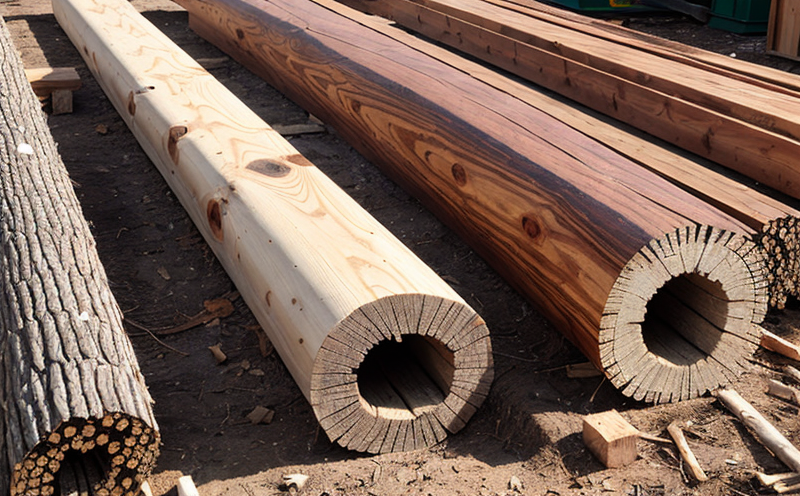Field Stake Test for Wood Durability
The field stake test (FST) is a critical method used to assess the durability of wood in natural environmental conditions. This testing procedure simulates real-world exposure by burying wooden stakes directly into soil, where they are subjected to moisture fluctuations and potential biological attack from fungi and insects. The FST provides valuable insights into how different species of wood perform under actual field conditions, making it an essential tool for quality managers, compliance officers, R&D engineers, and procurement teams in the agricultural and forestry sectors.
The test involves several steps: selecting appropriate wooden stakes, preparing them according to specific standards such as ISO 15138-2, burying them in a controlled field plot, monitoring their condition over time, and finally evaluating any signs of decay or insect damage. This approach allows for the collection of data that can be used to compare various wood species, treatments, and preservatives.
The FST is particularly useful in regions with diverse climates and soil types, as it reflects the wide range of environmental factors that can affect wood durability. By using this method, stakeholders gain a comprehensive understanding of how wood behaves under realistic conditions, which is crucial for selecting suitable materials for long-term outdoor applications such as fence posts, utility poles, and structural components in agricultural infrastructure.
One of the key advantages of the FST is its ability to provide results that are directly applicable to real-world scenarios. Unlike laboratory tests that may use artificial conditions, this field-based approach offers a more accurate prediction of how wood will perform over time. This makes it an invaluable tool for ensuring compliance with environmental regulations and standards.
Another significant benefit is the cost-effectiveness of the FST compared to other durability assessment methods. Field plots can be established relatively inexpensively, and once in place, they require minimal maintenance. The long-term nature of this test means that results are often available after a few years, providing valuable data for decision-making processes.
Despite its advantages, it's important to note that the FST does have limitations. It can be time-consuming due to the extended monitoring period required to observe significant changes in wood condition. Additionally, results may vary depending on specific field conditions and local environmental factors. However, these challenges are outweighed by the reliability of the data obtained.
For stakeholders involved in agricultural and forestry projects, the FST is an indispensable tool for ensuring that materials used meet durability requirements. By incorporating this test into their quality assurance protocols, they can make informed decisions about material selection and treatment methods, ultimately leading to more sustainable and cost-effective solutions.
- Direct applicability: Results closely mirror real-world conditions.
- Cost-effectiveness: Minimal ongoing costs once the field plot is established.
- Long-term data: Provides reliable information over extended periods.
- Compliance assurance: Supports adherence to environmental regulations and standards.
Why It Matters
The durability of wood is a critical factor in the design and maintenance of agricultural and forestry infrastructure. In environments exposed to outdoor conditions, wood can be subject to rapid deterioration due to moisture absorption and biological attack from fungi and insects. Ensuring that the materials used are durable and resistant to such degradation is essential for maintaining the integrity of structures and minimizing replacement costs.
The field stake test plays a crucial role in this process by providing empirical data on how different wood species and treatments perform under realistic conditions. This information is invaluable for quality managers, compliance officers, R&D engineers, and procurement teams who need to make informed decisions about material selection. By using the FST as part of their testing protocols, these stakeholders can ensure that they are selecting materials that are best suited to withstand the environmental challenges faced in agricultural and forestry applications.
The importance of this test extends beyond mere compliance with regulations; it also contributes to sustainable practices by promoting the use of durable materials that require less frequent replacement. This not only reduces waste but also helps to minimize the overall carbon footprint associated with construction and maintenance activities.
Quality and Reliability Assurance
The field stake test is a cornerstone of quality assurance programs in the agricultural and forestry sectors. By incorporating this method into their protocols, stakeholders can ensure that they are using wood products that meet durability requirements and comply with relevant environmental regulations.
One of the key aspects of reliability assurance is the consistent application of international standards such as ISO 15138-2 and ASTM D1414. These standards provide a framework for conducting field stake tests, ensuring that results are comparable across different testing facilities and locations. This consistency is crucial for maintaining confidence in the test results.
In addition to standardization, proper specimen preparation is essential for accurate results. Wooden stakes should be cut according to specified dimensions and prepared using appropriate treatments if necessary. The quality of these preparations can significantly impact the outcome of the test, making it important to follow best practices closely.
Regular monitoring and reporting are also critical components of a robust field stake test program. Stakeholders must establish clear protocols for data collection and analysis, ensuring that all relevant factors are accounted for in the evaluation process. This includes recording environmental conditions such as temperature, humidity, and rainfall, which can influence wood durability.
By implementing these best practices, stakeholders can achieve high levels of reliability and accuracy in their field stake test results. This not only enhances compliance with regulations but also promotes sustainable practices by selecting materials that are better suited to long-term outdoor applications.





